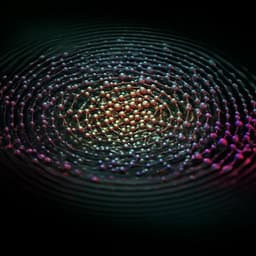
Physics
Emergent topological quantum orbits in the charge density wave phase of kagome metal CsV<sub>3</sub>Sb<sub>5</sub>
H. Tan, Y. Li, et al.
Dive into the fascinating world of Fermi surface properties in the three-dimensional charge density wave phase of CsV3Sb5. This research by Hengxin Tan and colleagues reveals complex Dirac nodal networks and their impact on quantum orbits, leading to the observation of topological phenomena influenced by spin-orbital coupling.
~3 min • Beginner • English
Introduction
The kagome superconductors AV3Sb5 (A = K, Rb, Cs) exhibit charge density waves (CDW), possible symmetry breaking without magnetism, topological band structures, and exotic superconductivity. Quantum oscillation studies of CsV3Sb5 report complicated sets of frequencies and conflicting identifications of nontrivial (π-phase) Fermi pockets. It is commonly assumed that a π phase shift reflects a π Berry phase from Dirac fermions, as in graphene. However, in spinful systems with sizable SOC (tens of meV in AV3Sb5), the total observed phase shift also includes orbital magnetic moment and Zeeman contributions, which are Fermi-energy dependent and inseparable from the Berry phase. Consequently, SOC-driven band anticrossings can cause π phase shifts even for orbits that are trivial without SOC, and conversely can suppress π Berry phases. Structurally, prior 2×2×1 CDW models (SD or ISD) fail to account for all measured oscillation frequencies; experiments indicate interlayer modulation with alternating SD and ISD layers, implying important out-of-plane reconstruction. The study aims to resolve the origin, structure, and topology of the observed quantum orbits in CsV3Sb5 by modeling a 3D 2×2×2 CDW and computing frequencies, masses, and phases across Fermi energies.
Literature Review
Prior works established AV3Sb5 as kagome metals with CDW, topological bands, and superconductivity, and reported anomalous transport phenomena. Multiple quantum oscillation studies on CsV3Sb5 found sets of frequencies spanning low (~0–250 T), medium (550–950 T), and high (≥1150 T) regimes, but disagreed on which pockets are topological (π phase). Earlier calculations based on 2×2×1 SD or ISD CDW could not simultaneously reproduce experimental frequencies across all regions. Recent ARPES and other experiments suggest interlayer modulation with alternating SD and ISD layers (e.g., 2×2×2 or 2×2×4), motivating a 3D CDW description. Theoretical analyses also emphasized that observed quantum-oscillation phases include orbital and Zeeman contributions in spinful systems, complicating direct Berry-phase interpretation.
Methodology
- Structures and electronic calculations: Density-functional theory (VASP) with fully relaxed structures; SOC included unless otherwise stated. Wannierization (V d and Sb p orbitals) used to construct high-resolution band structures and Fermi surfaces. Typical k-meshes: ≥100×100×50 for 2×2×2 CDW and ≥100×100×100 for 2×2×1 CDWs.
- Fermi surface and quantum orbits: Computed in-plane extremal (maximal/minimal) cross-sections along kz (magnetic field parallel to c). Cyclotron frequency F from Onsager relation F = (e/2πħ) Ae, where Ae is extremal orbit area. Cyclotron effective mass m* from m* = (ħ2/2π)(∂Ae/∂E).
- Phase analysis: Calculated Berry phases via Wilson loops without SOC for isolated spinless orbits. Under SOC, computed generalized Berry phases λα by evaluating the propagator U[C] along the orbit, incorporating non-Abelian Berry connection, orbital magnetic moment, and spin Zeeman contributions together (cannot be separated under SOC). Considered inversion and time-reversal symmetries leading to double degeneracy with opposite phases (±λ). Determined observable phase shift Δφ (0 or π) from the sign of cos(λ), accounting for Maslov correction and 3D kz integral. Classified nontrivial orbits (Δφ = π) into types I–IV based on the relative roles of Berry, orbital, and Zeeman phases.
- Model comparison: Evaluated 2×2×2 CDW (alternating SD/ISD layers) against experiments across Fermi energies circa −100 to 0 meV, focusing on −40 and −85 meV. Also assessed 2×2×1 SD and ISD models (Supplementary) for completeness.
Key Findings
- 3D CDW model agreement: The 2×2×2 CDW with alternating SD/ISD layers reproduces the number and distribution of quantum-oscillation frequencies observed experimentally across low (0–250 T), medium (550–950 T), and high (≥1150 T) frequency ranges, particularly near EF ≈ −40 and −85 meV.
- Frequency counts: At both −40 and −85 meV, the model yields 8 low-frequency and 7 medium-frequency orbits; high-frequency orbits are 1 (−40 meV) and 2 (−85 meV). High-frequency features beyond ~1800 T in experiments are likely due to magnetic breakdown, consistent with proximity of large pockets around Γ.
- Effective masses: Calculated m* values are consistent with experimental ranges (low-frequency: ~0.16–0.40 m0; medium/high: ~0.3–1.7 m0), matching better the datasets reporting larger low-frequency masses (e.g., Shrestha; Broyles). Examples: at −40 meV m* up to ~1.7–2.0 for 734–912 T orbits; at −85 meV m* up to ~2.10 for 672 T.
- Layer-resolved orbits: FSs and orbits separate into SD, ISD, and mixed (SD+ISD) contributions. About half are SD- or ISD-dominated; the rest are strongly mixed. Mixed orbits arise either from weakly hybridized segments (often at kz=0.5) or strongly hybridized contours (often at kz=0). Many small pockets are 3D, while many large ones are quasi-2D.
- Topology and phase shifts: Sixteen nontrivial (Δφ=π) quantum orbits identified across −40 and −85 meV. Nontrivial orbits fall into four types:
• Type I: π Berry phase from Dirac nodal lines/networks in spinless case (e.g., 14 T at −85 meV from D5; 30 T at −40 meV from P1; also 13 T at −40 meV). A hidden mirror-protected Dirac nodal network links points along MK and LH lines and forms nodal lines/rings (e.g., K1–H1 line).
• Types II–IV: Nontrivial Δφ arising from SOC and Zeeman effects (and orbital moment), often for orbits centered at time-reversal-invariant momenta (Γ, A, M, L), where φB and φorb vanish without SOC. SOC/Zeeman can induce Δφ=π even for spinless-trivial orbits.
- SOC/Zeeman suppression: Some orbits with spinless π Berry phase become trivial (Δφ=0) once SOC and Zeeman are included; e.g., the K–H nodal-line orbits near 605 and 617 T at −85 meV have large Zeeman phases (∝ m*) reducing |λ|<π/2.
- Reconciliation with experiments: Calculated nontrivial frequencies correspond well to reported values (e.g., exp 18 T ↔ 13/5 T; ~74–85 T ↔ 77/33 T; ~102 T ↔ 98/99 T; ~239 T ↔ 152 T; ~730–804 T ↔ 730/224–230/735/765 T; ~865 T ↔ 730–735 T), except for very high frequencies likely due to breakdown.
- Specific M-pocket mapping: Predicted small pockets near M associated with proposed loop-current scenarios: at −40 meV (20 T) the M-pocket (ISD-derived) carries no Berry phase under SOC without TRS breaking; at −85 meV (99 T) a mixed SD+ISD pocket at kz=0.5 has a Berry phase close to π, unique to 3D alternating stacking.
- Generality: Mirror-protected Dirac nodal lines (e.g., K–H) and their gapping by SOC are proposed as generic features in kagome materials, with implications for large Berry curvatures and possible drumhead surface states.
Discussion
The 3D 2×2×2 CDW with alternating SD/ISD layers resolves discrepancies between experiments and previous 2×2×1 models by capturing interlayer modulation that reconstructs the Fermi surface and yields the observed distribution of quantum-oscillation frequencies and effective masses. The identification of a hidden Dirac nodal network explains the presence of π-Berry-phase orbits in the spinless limit, while explicit inclusion of SOC and Zeeman effects clarifies why some experimentally observed π phase shifts can arise without a spinless Dirac Berry phase and why others with spinless π Berry phase become trivial. This unified treatment reconciles disparate reports of which frequencies are topological, demonstrating that Δφ in quantum oscillations is a generalized phase sensitive to SOC and Zeeman coupling, not merely the Berry phase. The work further highlights that many small Fermi pockets are intrinsically three-dimensional and strongly influenced by SD–ISD hybridization, underscoring the importance of interlayer structure in CsV3Sb5 and potentially other kagome systems.
Conclusion
This study develops a realistic 3D 2×2×2 CDW model for CsV3Sb5 that quantitatively matches quantum-oscillation frequencies and effective masses, and systematically determines the topology (phase shifts) of quantum orbits. It reveals a mirror-protected Dirac nodal network in the spinless limit and demonstrates the crucial role of SOC and Zeeman effects in producing or suppressing π phase shifts. The findings reconcile experimental disagreements on nontrivial orbits and provide a framework for disentangling structural (layer-resolved) and topological origins of quantum oscillations in kagome metals. Future directions include extending to more complex interlayer modulations (e.g., 2×2×4), explicit modeling of magnetic breakdown paths in high fields, probing predicted drumhead surface states, and exploring the interplay with possible time-reversal-symmetry-breaking loop-current phases.
Limitations
- High-frequency experimental oscillations (≥~1800 T) are likely dominated by magnetic breakdown between nearby large pockets; these are not fully captured in the base extremal-orbit analysis.
- Agreement at medium/high frequencies can depend sensitively on the exact Fermi energy, which varies across samples; low-frequency agreement is poorer for EF in the range [−20, 0] meV.
- The 2×2×1 CDW models (SD or ISD) cannot reproduce all experimental frequencies simultaneously; while the 2×2×2 model captures interlayer effects, more complicated stackings (e.g., 2×2×4) could introduce additional orbits and complexity.
- Under SOC, orbital and Zeeman contributions are inseparable from the Berry phase in the generalized phase; thus, attributing observed phase shifts to a single topological mechanism is not possible without full modeling.
- SOC weakly gaps nodal lines; residual gaps and sample-specific conditions may affect the observability of π-phase orbits.
Related Publications
Explore these studies to deepen your understanding of the subject.







